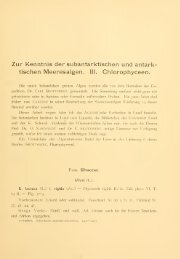Download PDF
Download PDF
Download PDF
You also want an ePaper? Increase the reach of your titles
YUMPU automatically turns print PDFs into web optimized ePapers that Google loves.
14<br />
ZYGNEMATACEAE<br />
In higher latitudes and altitudes the species are not well known<br />
because they rarely have been found with zygospores.<br />
In warm regions it is not improbable that some species are<br />
perennial; that is, some of the filaments form spores and die,<br />
while others merely break into segments which continue vegeta-<br />
tive growth. In well-aerated running water the Zygnemas are<br />
rarely found fruiting, but in the shallow pools adjoining such<br />
streams one can usually collect the same species in a fruiting<br />
condition.<br />
The average length of the filaments of Zygnemas is a few<br />
inches, much shorter than that of the Spirogyras. Apparently<br />
before the filaments become very long the pectic sheath breaks<br />
and the cells separate. Cell diameters vary from 8 to 58 /^ but more<br />
than half the species have cell diameters between 20 and 30M.<br />
Usually there are two axial chromatophores in each cell with<br />
the nucleus contained in the cytoplasmic bridge connecting them.<br />
Each chromatophore consists of a round body, with irregular short<br />
branches radiating in all planes, containing a conspicuous central<br />
pyrenoid. As a result of food accumulation the chromatophores<br />
may become merely two large globose bodies, or may completely<br />
fill the lumen of the cell.<br />
On rare occasions one may find filaments in which each cell<br />
has two axial chromatophores on either side of the nucleus. In<br />
three collections that I have examined there were four chroma-<br />
tophores in the cells of some filaments arranged in the form of<br />
an X with the nucleus in the center.<br />
Sexual reproduction occurs in 82 of the 95 described species.<br />
Twelve others reproduce by aplanospores, and i by akinetes only.<br />
Of the described species reproducing by zygospores 37 are isogamous,<br />
with spores in the conjugating tubes; and 45 are anisogamous,<br />
with spores in one of the gametangia. Of the 95 species,<br />
70 have scalariform conjugation, 9 both scalariform and lateral<br />
conjugation, and 3 lateral conjugation; no conjugation has been<br />
observed in the remaining species. Thirty species have blue<br />
median spore walls when mature. During development these<br />
walls change from colorless to yellow, to brown, to blue. As not<br />
all spores mature at the same time, one may find all these stages<br />
in a collection. If some of the spores are blue, one may be sure<br />
that the other spores in the filament are immature.<br />
Four chromatophores are usually visible in immature zygo-




